Best Representations of 3-Dimensional Symmetry: Isohedral
Steven Dutch, Professor Emeritus, Natural and Applied Sciences, University of Wisconsin - Green Bay
What Do We Mean By "Best?"
I was first inspired to consider this problem while building a set of solids to represent all 32 crystal classes (most commercial model sets omit the less common and less symmetrical classes). I soon realized the answers were different depending on whether I was cutting models out of wood or building them out of cardboard, and whether I was thinking of ease of construction or aesthetic appeal.
Some reasonable possible definitions of "best" include:
- Minimum number of faces
- Isohedral solids: faces all the same shape (obviously desirable for building cardboard models)
- Equilateral solids: all edges the same length
- Regular polygon faces: best for aesthetic appeal but it is known that not all crystal classes can be represented this way, at least not by convex models.
Triclinic
| 1 | |
| 1* |
Monoclinic
| 2 | |
| m | |
| 2/m |
Orthorhombic
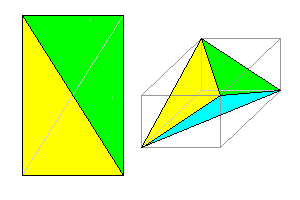 |
222
Orthorhombic disphenoid (shown viewed along 2-fold axis and as inscribed in rectangular prism.) 4 faces. Also minimal |
 |
mm
Orthorhombic fan: two or more tetragonal disphenoids side by side. 3k + 2 faces for k disphenoids. |
 |
2/m 2/m 2/m
Orthorhombic dipyramid 8 faces |
Uniaxial Classes
The uniaxial classes which have a single major symmetry axis and additional twofold axes or mirror planes all have certain features in common. For each group, whether trigonal, tetragonal or hexagonal, there are seven possible classes (but some turn out to be degenerate). These can all be derived by taking one of the seven strip space groups and wrapping it around a cylinder. If N is the degree of symmetry, we have:
- N
- A single major symmetry axis alone
- N/m
- Symmetry axis perpendicular to a mirror plane
- Nm
- Symmetry axis with mirror planes intersecting along the axis
- N/m m
- Symmetry axis perpendicular to a mirror plane, and mirror planes intersecting along the axis. A combination of N/m and Nm. This is the holosymmetric class: it contains all the other symmetries as subsets
- N2
- Symmetry axis with 2-fold axes perpendicular to it
- N*
- N-fold rotoinversion axis
- N*2m
- N-fold rotoinversion axis with 2-fold axes perpendicular to it and with mirror planes intersecting along the N-fold axis
Trigonal - Rhombohedral
| 3 | |
| 3m | |
| (Same as 6*) | 3/m |
| (Same as 6* 2/m) | 3/m m |
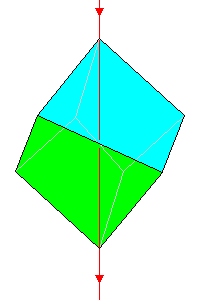 |
32
Skew trigonal trapezohedron 6 faces |
| 3* | |
 |
3*2m
Rhombohedron. Also minimal and equilateral 6 faces |
Tetragonal
| 4 | |
| 4/m | |
| 4mm | |
 |
4/m 2/m 2/m
Tetragonal dipyramid 8 faces |
 |
422
Skew tetragonal trapezohedron 8 faces |
| 4* | |
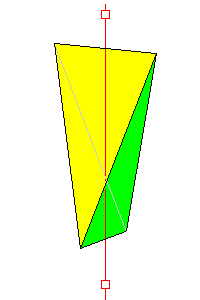 |
4* 2/m
Tetragonal disphenoid. Also minimal 4 faces. |
Hexagonal
| 6 | |
| 6/m | |
| 6mm | |
 |
6/m 2/m 2/m
Hexagonal dipyramid 12 faces |
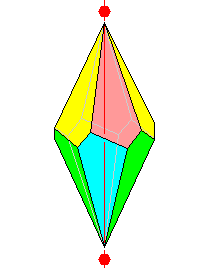 |
622
Skew hexagonal trapezohedron 12 faces |
| 6* | |
 |
6* 2m
Trigonal dipyramid. If faces equilateral (two tetrahedra base to base) then crystal is equilateral and regular-faced. 6 faces |
Isometric
 |
4/m 3* 2/m
Cube. Also equilateral, minimal and regular-faced. Other isohedral examples are the octahedron and rhombic dodecahedron, and all closed forms of this class 6 faces. |
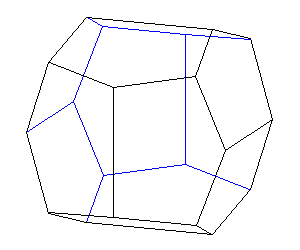 |
2/m 3*
Non-regular pentagonal dodecahedron (pyritohedron) 12 faces |
 |
4* 3m
Tetrahedron. Also equilateral, minimal and regular-faced. Other isohedral examples are all closed forms of this class 4 faces |
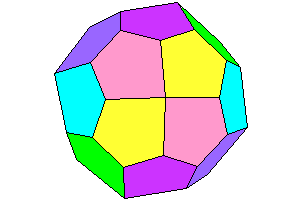 |
432
Gyroid 24 faces |
 |
23
Tetartoid 12 faces |
Return to Symmetry Index
Return to Professor Dutch's Home page
Created 31 July 2001, Last Update 11 June 2020